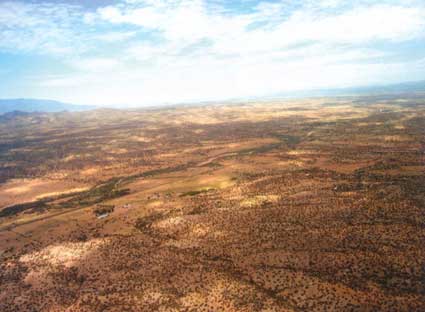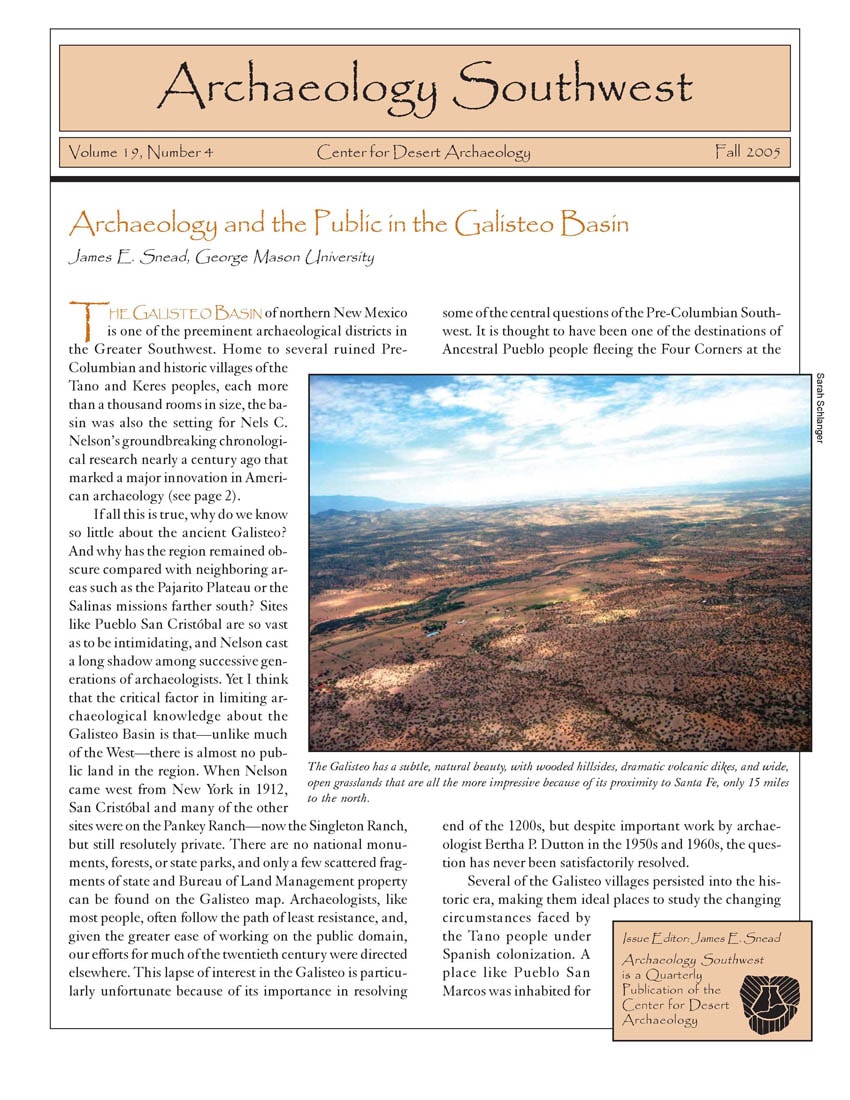Archaeology and the Public in the Galisteo Basin

The Galisteo has a subtle, natural beauty, with wooded hillsides, dramatic volcanic dikes, and wide, open grasslands that are all the more impressive because of its proximity to Santa Fe, only 15 miles to the north.
Archaeology Southwest Magazine Vol. 19, No. 4
FREE PDF DOWNLOAD
Issue editor: James E. Snead, George Mason University
The Galisteo Basin of northern New Mexico is one of the preeminent archaeological districts in the Greater Southwest. Home to several ruined Pre-Columbian and historic villages of the Tano and Keres peoples, each more than a thousand rooms in size, the basin was also the setting for Nels C. Nelson’s groundbreaking chronological research nearly a century ago that marked a major innovation in American archaeology.
If all this is true, why do we know so little about the ancient Galisteo? And why has the region remained obscure compared with neighboring areas such as the Pajarito Plateau or the Salinas missions farther south? Sites like Pueblo San Cristobal are so vast as to be intimidating, and Nelson cast a long shadow among successive generations of archaeologists. Yet I think that the critical factor in limiting archaeological knowledge about the Galisteo Basin is that–unlike much of the West–there is almost no public land in the region. When Nelson came west from New York in 1912, San Cristobal and many of the other sites were on the Pankey Ranch–now the Singleton Ranch, but still resolutely private. There are no national monuments, forests, or state parks, and only a few scattered fragments of state and Bureau of Land Management property can be found on the Galisteo map. Archaeologists, like most people, often follow the path of least resistance, and, given the greater ease of working on the public domain, our efforts for much of the twentieth century were directed elsewhere. This lapse of interest in the Galisteo is particularly unfortunate because of its importance in resolving some of the central questions of the Pre-Columbian Southwest. It is thought to have been one of the destinations of Ancestral Pueblo people fleeing the Four Corners at the end of the 1200s, but despite important work by archaeologist Bertha P. Dutton in the 1950s and 1960s, the question has never been satisfactorily resolved.
The articles in this issue of Archaeology Southwest Magazine look at new research in the Galisteo Basin from a variety of perspectives. Some present vexing archaeological questions, while others address concerns of public policy or reflect points of view that may differ considerably from those of institutionally based archaeologists. All, however, address two themes: first, that the Galisteo is a rich resource for the cultural heritage of the Southwest, and second, that we will never be in a position to understand it better unless the public is a full partner in our work.
Articles include:
Archaeology and the Public in the Galisteo Basin – James E. Snead, George Mason University
The Galisteo Basin Archaeological Sites Protection Act – Signa Larralde, Bureau of Land Management, and Bob Powers, National Park Service
Dutton’s Dirty Diggers: A Special Kind of Public Archaeology — Leslie Cohen, Laboratory of Anthropology
The Archaeological Society of New Mexico and the Rock Art of the Galisteo Basin — J. J. Brody, University of New Mexico
Burnt Corn Pueblo and the Tano Origins Project — James E. Snead, George Mason University
The Petroglyph Hill Survey — James E. Snead, George Mason University, and Genevieve Head, Cabezon Consulting
Petroglyph Hill Past and Present — Marit Munson, Trent University
Mission Archaeology in the Galisteo Basin — Cordelia Snow, New Mexico Historic Preservation Division
Excavations at Paa-ko Pueblo — Mark Lycett, University of Chicago
A Model for Community Action and Preservation — Leslie Cohen, Laboratory of Anthropology
Preservation Efforts in the Galisteo Basin — Tamara Jager Stewart, The Archaeological Conservancy
Site Stewardship at Pueblo San Marcos — Bill Baxter
Back Sight — William H. Doelle, Center for Desert Archaeology
Subscribe

